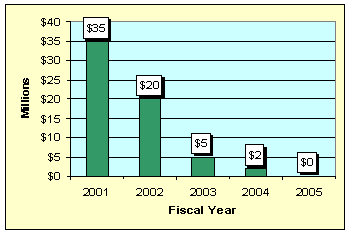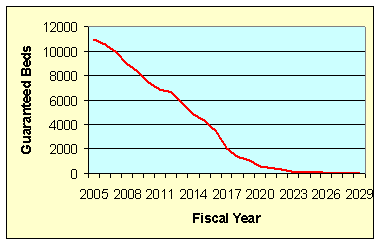The United States Marshals Service (USMS) is responsible for the custody and transportation of detainees awaiting trial in federal courts. Most of the 49,000 USMS detainees in custody daily are held in state, local, and private jail facilities. One of the Department of Justiceís strategic goals is to ensure the fair and efficient operation of the federal justice system. The Department seeks to achieve this goal in part by providing for the safe, secure, and humane confinement of detained persons awaiting trial and sentencing through a multi-pronged approach using:
- Cooperative Agreement Program (CAP) agreements with state and local jails, where capital investment funding is provided in exchange for guaranteed bed space;
- Intergovernmental Service Agreements (IGAs) with state and local jails, where a daily rate is paid to the jails to house detainees;
- private jail facilities, where a daily rate is paid to house detainees; and
- federal detention facilities, where the government pays for construction and operation of the facilities.
Detention and incarceration is a top management challenge in the Department of Justice in part because of the current overcrowding rate in federal prisons. Overcrowding in federal prisons also limits the option of using federal prisons to house USMS detainees. In addition, the USMS is reluctant to use private jail facilities because the jails usually require a minimum number of detainees to be housed. Consequently, the USMS primarily has used IGAs and CAP agreements to meet its needs for detention space.
In locations where detention space is scarce, the USMS negotiates with state and local governments to provide an agreed-upon amount of CAP funds to improve local jail facilities or expand jail capacities. In return, the state and local governments guarantee the USMS an agreed-upon number of bed spaces for a specified number of years. Use of the bed space also requires an IGA between the USMS and the facility. When the USMS uses the bed space guaranteed by the CAP, it pays a jail day rate to the facility for each detainee negotiated through the IGA. The jail day rate is based on the annual operating cost of the facility and can be periodically modified.
For many years, CAP agreements have been a significant tool used by the USMS to guarantee detention space in court cities where detention space is scarce.1 Since 1982, the USMS has awarded about $285 million to counties and municipalities under CAP agreements, resulting in more than 13,600 guaranteed spaces for federal detainees. However, in recent years Congress steadily reduced the appropriation for the CAP program and eliminated funding for the program altogether for Fiscal Year (FY) 2005.
CAP Funds Appropriated2
FY 2001 Ė FY 2005

| Source: Office of Justice Programs Appropriations |
Our audit focused on whether the USMS has developed adequate plans, in the absence of CAP funding, to secure jail space in cities where CAP agreements will expire during the next three fiscal years, and where jail space is scarce but no CAP agreements exist.
While bed spaces guaranteed by CAP agreements are decreasing and CAP funding was eliminated in FY 2005, the USMSís average daily detainee population increased by about 34 percent from FY 2001 to FY 2004. As of FY 2005, the USMS has active CAP agreements that guarantee 11,203 bed spaces that will expire between 2005 and 2029. Thirty-one CAP agreements, guaranteeing 1,318 bed spaces annually, will expire during the remainder of FY 2005 through FY 2007. The remaining 149 active CAP agreements, guaranteeing 9,885 bed spaces annually, will expire from FY 2008 through FY 2029. The following chart illustrates the loss of the 11,203 beds guaranteed through CAP funding as of January 13, 2005, if CAP funds are not restored in future appropriations.
Declining Number of Guaranteed Beds from
Expiring CAP Agreements (FY 2005 - FY 2029)

| Source: USMS CAP Agreement Files |
In addition, the USMS has identified 47 court cities where detention space is a serious or emergency problem but, because CAP funding has been eliminated, funds are not available to award CAP agreements. The USMS identified 41 of the 47 court cities as having a serious problem and the remaining 6 court cities as having an emergency problem. In court cities with an emergency situation, the USMS District offices must transport detainees to out-of-district facilities from 40 to 400 miles from the court city. One District reported that it is transporting detainees to 15 different jails in 5 different states.
The USMS has continued to secure detention space through traditional means such as the use of IGAs, private jail contracts, and Federal Bureau of Prisons (BOP) facilities. However, it is questionable whether the USMS will be able to meet detention space needs through these traditional means once CAP funding expires. USMS officials told us that finding detention space across the country will not be a problem but finding bed space in close proximity to the court cities where bed space is needed will be a problem. The officials said that they plan to use traditional methods for securing jail space, such as negotiating IGA agreements with state and local governments and private jail contractors, and housing detainees at BOP facilities. However, the USMSís plans were only verbally expressed and the USMS provided no evidence to show that it had performed research or analyses to determine: 1) whether state and local governments with expiring CAP agreements would continue housing prisoners, and at what cost, through IGAs in the absence of CAP funds; and 2) alternate locations, where detainees could be housed, and at what cost, if current CAP sites decide to discontinue housing USMS detainees when CAP funding ends. Because the USMS had not thoroughly researched and addressed these issues, we concluded that the USMS cannot assure that adequate detention space, at a reasonable cost, will be available to meet the USMSís detention space needs as existing CAP agreements expire.
In addition, in evaluating the CAP funding appropriated for FY 2001 through FY 2005, we determined that the USMS could not document what happened to part of the funds appropriated for the INS. At the beginning of FY 2004, the USMS had a balance of $10,339,540 that had been appropriated for the INS CAP agreements. The USMS provided documentation to show that Congress rescinded $9,600,000 because the INS had been transferred to the Department of Homeland Security, leaving a balance of $739,540. We inquired of USMS and Office of the Federal Detention Trustee (OFDT) officials as to what happened with the remaining $739,540, but neither could provide an explanation.3
We also determined that based on the USMSís documentation, the USMSís available balance for CAP agreements at the end of FY 2004 was $2,441,848. However, documentation provided by the OFDT showed the balance should be $2,191,269, a difference of $250,579. Similarly, we asked USMS and OFDT officials to explain the difference, but neither could.
In this report, we recommend that the USMS develop specific plans for securing detention space absent CAP funding. We also recommend that the USMS address the:
- $739,540 in CAP funds provided for INS CAP agreements that was not rescinded by Congress, and
- $250,579 difference between the available balance for CAP agreements at the end of FY 2004 based on the USMSís records ($2,441,848) and the available balance for CAP agreements at the end of FY 2004 based on documentation provided by OFDT ($2,191,269).
- Court cities are the cities throughout the United States where the Federal courts are located and to which the USMS must transport detainees.
- The CAP funding is appropriated annually in the Office of Justice Programs approved budget and the funds are transferred to the USMS for management and execution of the CAP program. The CAP funds appropriated for FY 2001 through FY 2003 included funds for both the USMS and Immigration and Naturalization Service (INS) CAP agreements. The INS was transferred from the Department of Justice to the Department of Homeland Security in March 2003. The CAP funds appropriated after FY 2003 are for USMS CAP agreements only.
- The OFDT was created in FY 2001 to centralize the detention functions within the Department of Justice.


